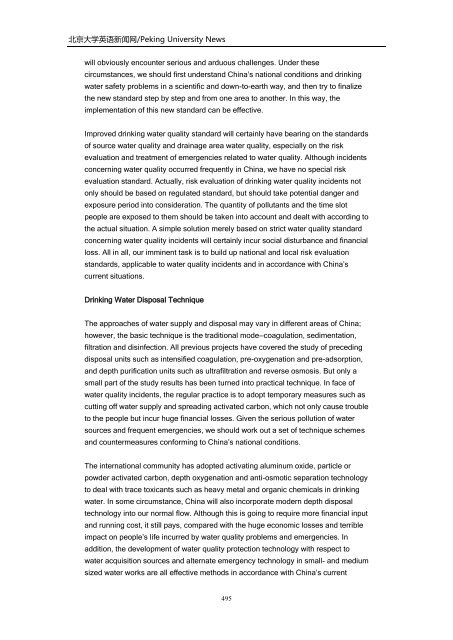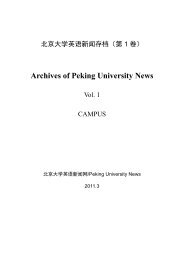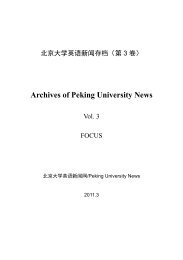Archives of Peking University News - PKU English - 北京大学
Archives of Peking University News - PKU English - 北京大学
Archives of Peking University News - PKU English - 北京大学
Create successful ePaper yourself
Turn your PDF publications into a flip-book with our unique Google optimized e-Paper software.
<strong>北京大学</strong>英语新闻网/<strong>Peking</strong> <strong>University</strong> <strong>News</strong><br />
will obviously encounter serious and arduous challenges. Under these<br />
circumstances, we should first understand China‘s national conditions and drinking<br />
water safety problems in a scientific and down-to-earth way, and then try to finalize<br />
the new standard step by step and from one area to another. In this way, the<br />
implementation <strong>of</strong> this new standard can be effective.<br />
Improved drinking water quality standard will certainly have bearing on the standards<br />
<strong>of</strong> source water quality and drainage area water quality, especially on the risk<br />
evaluation and treatment <strong>of</strong> emergencies related to water quality. Although incidents<br />
concerning water quality occurred frequently in China, we have no special risk<br />
evaluation standard. Actually, risk evaluation <strong>of</strong> drinking water quality incidents not<br />
only should be based on regulated standard, but should take potential danger and<br />
exposure period into consideration. The quantity <strong>of</strong> pollutants and the time slot<br />
people are exposed to them should be taken into account and dealt with according to<br />
the actual situation. A simple solution merely based on strict water quality standard<br />
concerning water quality incidents will certainly incur social disturbance and financial<br />
loss. All in all, our imminent task is to build up national and local risk evaluation<br />
standards, applicable to water quality incidents and in accordance with China‘s<br />
current situations.<br />
Drinking Water Disposal Technique<br />
The approaches <strong>of</strong> water supply and disposal may vary in different areas <strong>of</strong> China;<br />
however, the basic technique is the traditional mode—coagulation, sedimentation,<br />
filtration and disinfection. All previous projects have covered the study <strong>of</strong> preceding<br />
disposal units such as intensified coagulation, pre-oxygenation and pre-adsorption,<br />
and depth purification units such as ultrafiltration and reverse osmosis. But only a<br />
small part <strong>of</strong> the study results has been turned into practical technique. In face <strong>of</strong><br />
water quality incidents, the regular practice is to adopt temporary measures such as<br />
cutting <strong>of</strong>f water supply and spreading activated carbon, which not only cause trouble<br />
to the people but incur huge financial losses. Given the serious pollution <strong>of</strong> water<br />
sources and frequent emergencies, we should work out a set <strong>of</strong> technique schemes<br />
and countermeasures conforming to China‘s national conditions.<br />
The international community has adopted activating aluminum oxide, particle or<br />
powder activated carbon, depth oxygenation and anti-osmotic separation technology<br />
to deal with trace toxicants such as heavy metal and organic chemicals in drinking<br />
water. In some circumstance, China will also incorporate modern depth disposal<br />
technology into our normal flow. Although this is going to require more financial input<br />
and running cost, it still pays, compared with the huge economic losses and terrible<br />
impact on people‘s life incurred by water quality problems and emergencies. In<br />
addition, the development <strong>of</strong> water quality protection technology with respect to<br />
water acquisition sources and alternate emergency technology in small- and medium<br />
sized water works are all effective methods in accordance with China‘s current<br />
495




